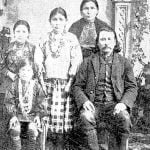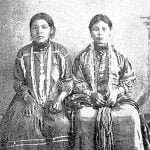Report of Special Agent Reuben Sears on the Indians of the Sac and Fox tract or reservation, Sac and Fox agency, Tama County, Iowa. 2.5 miles from the town of Tama, September 1890.
Names of Indian tribes or parts of tribes occupying said reservation: (a) Pottawatomie, Sac (Sauk) and Fox of the Mississippi, and Winnebago.
The unallotted area of this tract is 1,258 acres, or 2 square miles. The tract has been surveyed and subdivided. It was established by purchase. (See act of Congress approved. March 2, 1867, 14 U. S. Stats, p. 507.) Deeds November 1870, and 1882 and 1883. Indian. population 1800: 397.
Sac and Fox Reservation

This reservation is one only in name, as the Sacs and Foxes own it in fee, the deed to the same being held in trust by the governor of Iowa. On this these Indians have lived surrounded by the whites for the last 30 years, and should now be in a fair state of civilization if white influence has much power in molding Indian character. In fact, this tribe shows but little civilized or Christianized results from such surroundings. Their physical condition is comparatively good; a few seem troubled with a cough and other evidences of chronic lung trouble, but then a majority give every indication of health. Their children are to all appearance healthy, and behave quite as well as the children of the average whites.
The economic condition of these Indians is far from flattering either to those around them or to the persons who have been placed in charge of them by the government. They are generally heavily in debt, and a large part of their annuities from the United States goes to pay these debts in part, leaving them still in debt, and ready to go in debt again until another government pay day. Many are industrious, and are willing to make every effort to be self-supporting. They try to raise corn, potatoes, and vegetables, and some have very fair crops. Almost all raise ponies. Their wealth consists in their lands, which they own in common; in all, 1,452 acres. 1 This land, lying in the Iowa river bottoms, together with their ponies, constitutes their property. The larger part of the land is a rich, deep, alluvial soil, and, properly cultivated, will produce good crops. A portion is covered with good timber. This is subject to an overflow from the river in high water, but at other times affords good pasturage. Their houses are of the primitive style. In summer they live in camps in lodges made usually of bark, but sometimes of rough boards and covered with bark or rush matting. They have platforms on each side, raised several feet from the ground, on which they sleep and lounge away the time. They make a fire in the center, where they cook their food, but their cooking utensils are very few and poor, principally pots and kettles. In winter they leave these camps and go near the timber skirting the hills and live in wigwams built of poles and covered with bark or matting made of rushes, with an opening at the top to let out the smoke from the fire built in the middle, which keeps them warm. They have no stoves for cooking or heating purposes, no furniture, beds, tables, or other conveniences. They eat on the ground and sleep on blankets. They are pagans, self-reliant and determined in this belief. The Presbyterian Board of Missions has for several years past bad a lady missionary in this vicinity.

The employment of these people is farming and trading horses, if it can be fairly said they have any employment. They have some 600 ponies. They are healthy and vigorous, but as a rule lazy and shiftless. They seem to have no aim in life but to get enough to live on and keep warm. A few of them are really progressive, but they have a poor chance to do much. These people are honest and mean well; but when they try to make progress they find that they do not know bow. They seem to he in a condition of chronic uselessness. They have neither teacher nor farmer to instruct them in education or farming or to care for or advise them; neither have they any mechanic to assist them. No one has any authority over them. They look for advice to their old chiefs, who are determined they shall think and do as they have done in the past. While these Indians have always had enough to eat, they have been wholly left to themselves. They have been the same Indians to all appearance for the last 30 years. They are practically one family and live almost as such, the small area of their land necessitating this. As to their progress, they have advanced to a certain extent. They have ceased to practice polygamy, and husband and wife live together during life. Their dress is generally of the primitive style (blanket, clout, and breeches) when among the whites, but in their camps in summer they are nearly nude. Little progress in education or firming is evident, and improvement in their houses is not perceptible. There is only 1 agency building, a schoolhouse not in use, which is being enlarged for use this winter. In good repair it would be worth $700. There is no church on the reservation.
There were on the pay roll for 1889, 395; on the pay roll for 1890, 402; showing an apparent increase of 7. The births the last year were 19, and. the deaths, as recorded, 21. One would say they are decreasing but there is no agency physician, and this record is very liable to be inaccurate. The great fatality last year was from the grippe, which prevailed very generally among them, and was aided by their having no physician and relying on the medicine men, along with the exposure in their comfortless homes. There seems to be a fair degree of longevity among them. One squaw, named Me-na-cha-qua, is said to be 108 years of age, and over 50 names on the pay roll are of persons over 50 years of age. There have been very few cases of drunkenness among them.

These Indians believe that they must not raise more corn, beans, or other things than they need, so that it will waste on the ground and rot. If they do it will die, and that which is planted afterward will not yield good crops, and what does grow will be of very bad, quality, so that when they eat it they will become sick; gradually they will grow worse, they will suffer from diseases, become weak, and cough, their systems will run down, and so after awhile they will die.
The Sac and Fox Indians are very superstitions about eating the first of the crops they raise. When an Indian’s corn, beans, or other vegetables are ripe enough to eat they do not dare to partake of them until they first have a gathering of certain persons among them, when they go through certain rites and ceremonies for several hours, and then have a feast off the new crop, after which it is safe and proper for the owner to use his crop as be chooses.
This tribe needs looking after. There is good material in it, and they should be helped forward. Nature has aided them in remaining wild Indians by giving them a productive tract of land, which they own. They should have a school, be given a farmer, and aided to become more cleanly and industrious. All expenditures on this account should be for the improvement of the body, mind, and habits of these people.
Being owners in fee of their lands, it is of course a serious question as to what and how much the government can do in attempting to control these people. Either the state of Iowa or the nation should assist them toward a higher civilization.
Allotment of lands will not much aid them, as they number 397 and have but 1,452 acres of land. Allotment would mean about 4 acres of land to a person. These people on account of small land holding are thus forced to live in community. It would seem under this state of facts that now is a good time to take them up and assist in their development and see whether the Indian can live best in community. Either this must be done or they should be removed to a tract of country where more land can be obtained by or for them.
Citations:
- As reported by the Indian agent to the Indian Office, Op cit., page 103. The difference represents an addition to the original purchase.[↩]
Discover more from Access Genealogy
Subscribe to get the latest posts sent to your email.
